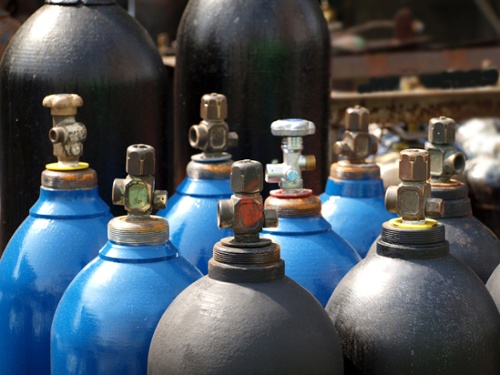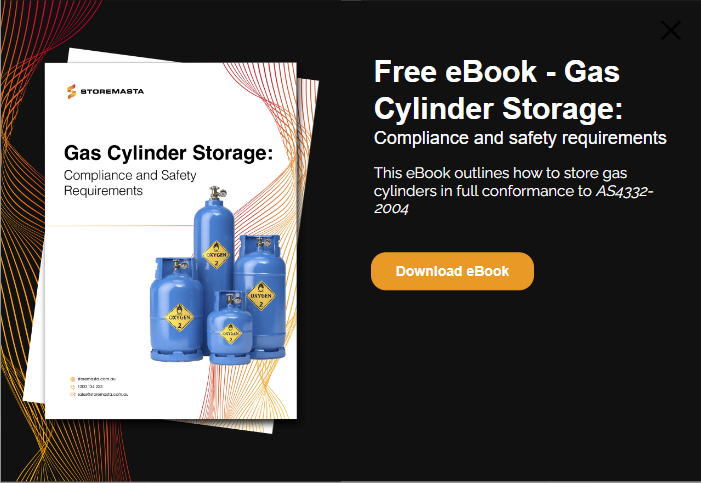While it’s easy to be wise after the event, it’s essential that workplace accidents are analysed to prevent them occurring again in the future. In this post, we’ll be looking specifically at the prevention of gas bottle incidents through the implementation of some simple handling or storage practices. By unpacking key requirements of the Australian Standard AS 4332 - The storage and handling of gases in cylinders, we’ll look at three accidents involving gas cylinders that could have been avoided if these safety standards were followed.
PLEASE NOTE: This blog references some serious gas cylinder accidents that occurred in overseas workplaces. However, it’s not about establishing blame or pointing the finger. Our post is focused on demonstrating how standard safety measures can help you avoid dangerous incidents involving compressed gases in cylinders.
1. Using a Gas Cylinder at Height
Two workers needed to use compressed nitrogen gas to leak-test some HVAC units installed in the roof of a warehouse. To reach the HVAC units, the workers used a rolling staircase with a landing platform then continued up a fixed ladder. One worker tried to climb the fixed ladder while holding a 15.8kg nitrogen cylinder in one hand. He lost his balance and fell, hitting first the landing area then continued falling more than 5 metres to the concrete floor below. He broke his back.
Even though this gas bottle accident caused a lifelong injury to one of the workers, the incident could have been a whole lot worse. The gas cylinder could have struck another worker, or the impact from the fall could have ruptured the cylinder turning it into a torpedo like projectile.
Section 5 of AS 4332 (which deals with operational and personnel safety) requires that a suitable cylinder trolley or gas bottle lifting device must be used when moving gas cylinders about the workplace.
Additionally, gas cylinders must be kept securely restrained while being moved so their valves and any fitted regulators cannot be damaged.
In this instance, a safe work area could have been created by transporting the heavy nitrogen cylinder in a gas cylinder cage or lifting cradle. The gas cylinder cage could then be kept in place for the duration of the scheduled maintenance on the HVAC units. Compliant gas bottle cages have inbuilt dividing bars and cylinder restraints to prevent the cylinders moving while being lifted and transported.
IMPORTANT: Learn more about improving gas bottle safety in your workplace by reading our blog, How to Safely Handle Gas Cylinders.
2. Transferring Gas Bottles Onsite
A worker was moving an empty nitrogen gas cylinder down a passageway. He was pushing the cylinder along the ground while pulling an empty cylinder trolley along behind him. Somehow, the wheels of the gas cylinder trolley became jammed in a crack on the floor and the whole cylinder trolley tipped over. This resulted in the worker’s index finger becoming trapped between the cylinder and the gas bottle trolley. His finger was later amputated.
As we outlined in example 1, the Australian Standard requires that gas bottles must be secured during transfer or movement about the worksite. Therefore, mechanical lifting devices and trolleys must be used at all times.
Had the worker transferring gas bottles used the cylinder trolley properly, he would very likely still have all 5 of his fingers.
Of course, we have no way of knowing why this worker (who had the correct safety equipment in his possession) chose not to use it.
It could be an indication that:
- The worker didn’t understand the full extent of the dangers and hazards when transporting the cylinders
- The worker didn’t know that empty cylinders must be handled and stored in the same way as full cylinders
- The worker had not received suitable task-specific training and didn’t know how to use the cylinder trolley properly
- There was inadequate supervision at the worksite
- Risk assessments conducted on the manual handling tasks at the worksite were inadequate and had led to the purchase of handling equipment not suited to the gas cylinders actually being used
The Standard requires that staff and contractors are given thorough training, so they can understand the full risks to their safety when handling the gas cylinders. They must know their responsibilities under the law and be trained on how to properly use gas bottle safety equipment and the appropriate PPE. At the same time, observation on the job and regular follow up training is required to ensure gas bottle safety.
3. Correctly Identifying Gas Bottles
A worker at a metal recycling plant was using a large backhoe to shear and crush metal. In the pile of rubble, he came across a gas cylinder and (only noting the colour of the cylinder) wrongly assumed it was an oxygen cylinder. The empty cylinder, however, still contained acetylene, which is a Class 2.1 Flammable Gas. When the shearing jaws of the backhoe crushed the gas cylinder, it exploded and a large fireball was created. The worker suffered severe burns in the fire.
The Standard clearly states that the colour of a cylinder should never be used as the sole means of identifying the contents. Additionally, the original owner of the acetylene cylinder had a duty of care. This duty of care includes the safe disposal of old and damaged gas cylinders.
Even ‘empty’ cylinders contain residue of the gases previously stored. This means that a gas bottle explosion can occur if empty gas cylinders aren’t handled and stored correctly.

Empty gas cylinders can still hold small amounts of hazardous gases, which can lead to safety issues if they're not handled, stored and disposed of correctly.
Always remember that empty gas bottles should be treated with the same care and responsibility as full cylinders. While an acetylene cylinder should never have been sent to a scrap metal facility in the first place, backhoe operators and sorters must receive adequate training so they can avoid a gas bottle accident if they encounter gas cylinders.
How to Prevent a Gas Cylinder Incident
For more information about how to safely handle and store gas cylinders at your workplace (and meet the requirements of AS 4332 - The storage and handling of gases in cylinders) download our free eBook Gas Cylinder Storage: Compliance and safety requirements. We use genuine workplace examples and case studies to demonstrate how the Standard works in the real world. Grab your own copy to learn more today.
Joining the team as a Dangerous Goods Storage Consultant, Melissa Hampton became Storemasta's Marketing Manager in late 2021. With extensive knowledge and experience in chemical compliance, Melissa is responsible for leading the Marketing team and helping shape their marketing strategy. In her spare time, you can find Melissa hiking, swimming and enjoying the great outdoors in beautiful north-west Tasmania.
